
(The quote of the day section is back...)
"Any intelligent fool can make things bigger, more complex, and more violent. It takes a touch of genius -- and a lot of courage -- to move in the opposite direction."
I received this tale today...
"This is the fairy tale that we should have been reading as little girls!
Once upon a time, in a land far away, a beautiful, independent, self-assured princess happened upon a frog as she sat, contemplating ecological issues on the shores of an unpolluted pond in a verdant meadow near her castle.
A frog hopped into the princess' lap and said: Elegant Lady, I was once a handsome prince, until an evil witch cast a spell upon me.
One kiss from you, however, and I will turn back into the dapper, young Prince that I am and then, my sweet, we can marry and set up housekeeping in yo ur castle with my mother, where you can satisfy my needs, prepare and serve my meals, clean my clothes, bear my children, and forever feel grateful and happy doing so.
ur castle with my mother, where you can satisfy my needs, prepare and serve my meals, clean my clothes, bear my children, and forever feel grateful and happy doing so.
That night, as the princess dined sumptuously on lightly sautéed frog legs seasoned in a white wine and onion cream sauce, she chuckled and thought to herself:
I DON'T F***ING THINK SO!!!!!
Share with all the princesses you know! It's sure to brighten their day!"
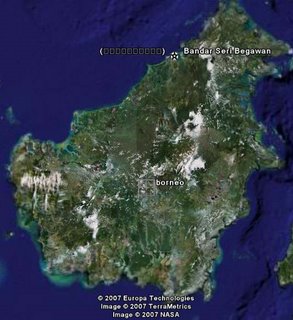 As the tourists call it, ‘Borneo’, is the third largest island in the world (after Greenland and New Guinea) with its 748,168km2 area. It is also the sixth highest island in the world. It is administratively divided between Malaysia, Brunei, and Indonesia and among them nine provinces; but ecologically it can be divided into seven ecoregions: The Borneo lowland rain forests, Borneo peat swamp forests, the Kerangas (Sundaland heath forests), the Southwest Borneo freshwater swamp forests, and the Sunda Shelf mangroves, Central Borneo’s montane rain forests, and the higher Kinabalu montane alpine meadows. Hence the 30 ethnic groups living on the island share it with about 15,000 species of flowering plants, 3,000 species of trees, 221 species of terrestrial mammals, and 420 species of resident birds.
As the tourists call it, ‘Borneo’, is the third largest island in the world (after Greenland and New Guinea) with its 748,168km2 area. It is also the sixth highest island in the world. It is administratively divided between Malaysia, Brunei, and Indonesia and among them nine provinces; but ecologically it can be divided into seven ecoregions: The Borneo lowland rain forests, Borneo peat swamp forests, the Kerangas (Sundaland heath forests), the Southwest Borneo freshwater swamp forests, and the Sunda Shelf mangroves, Central Borneo’s montane rain forests, and the higher Kinabalu montane alpine meadows. Hence the 30 ethnic groups living on the island share it with about 15,000 species of flowering plants, 3,000 species of trees, 221 species of terrestrial mammals, and 420 species of resident birds. The word Borneo comes from the Malay word Brunei, one of the largest cities on the island, and was changed by the Portuguese to Borneo. Historically, however, the word belongs to the colonisers (the Dutch, who has weird ways of calling pretty much everything, even themselves, so Borneo is still quite ok. To clarify, I mean the pronunciation of Dutch words in general, which I find quite difficult –which of course is none of my fault ;P But the name joke is even better: together with China, the Netherlands are one the two countries whose dominant population tries to make a cool name out of their long and cumbersome –in this case Christian- names…) so is obsolete among Indonesians, although the tourists for some reason cannot figure this out. Maybe if Lonely Planet (the bible) highlighted this fact it would be educational for some poor western souls...
Anyway, in Indonesia, the island is always referred to as Kalimantan while in Malaysia the northern section is referred to as East Malaysia (as opposed to Western reference of Malaysian Borneo). The Indonesian part occupies the central and southern regions of the island. So I establish that I was in Kalimantan, after a one-night-stay in Java in which (after Aceh) I celebrated being back to a more familiar world (the world of Bintang and familiar faces).
But first I’ve to tell you about the trip: I left Aceh on a foggy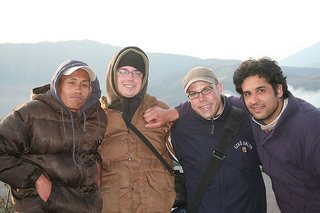 day with a Garuda flight. To my surprise they were much better this time: they are on time and they get you where you want to go to unlike some other airlines that were operating at that time: the plane crashed.
day with a Garuda flight. To my surprise they were much better this time: they are on time and they get you where you want to go to unlike some other airlines that were operating at that time: the plane crashed.
I found the hotel Harro “texted” (I can’t get used to this “verb”!) quite easily, liked whatever I saw of Semerang from the taxi (which was very little, but still… I liked the complexity already), joined  Vince, Harro, Rob and Timme (from right to left in the pic) in the pub with a few pitchers of Bintang. They were at the end of their Java trip and told me of Mount Bromo and Borobudur (see what I missed/saved f
Vince, Harro, Rob and Timme (from right to left in the pic) in the pub with a few pitchers of Bintang. They were at the end of their Java trip and told me of Mount Bromo and Borobudur (see what I missed/saved f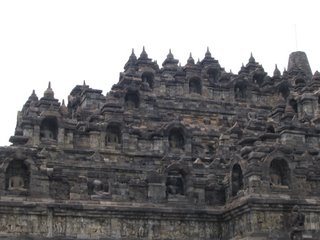 or the next trip in the pics) and me about Aceh –a little non-stop I’m afraid...
or the next trip in the pics) and me about Aceh –a little non-stop I’m afraid...
Naturally, the next morning was one marked by a huge hangover. We also experienced our 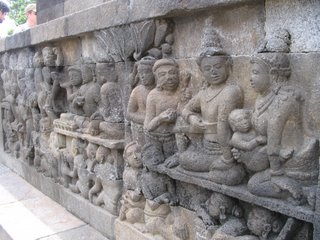 first delay (which foreshadowed our Christmas day) and out first tiny plane that morning. Yet, we managed to get to Pangkalanbun, then to Kumai, where we were to stay for one night before we started our trip to the rainforest. We got the necessary permits to make the trip and fixed a boat that would be our transport, accommodation and restaurant for the next five days. But Kumai was a hit: The hotel we stayed at, the Aloha Inn, was the filthiest place I’ve ever stayed (for the details refer to the 72nd paragraph of Rob’s post on Indonesia and NOT to the bible, as all holy texts it has its limits and probably not very updated). The town in general was ha
first delay (which foreshadowed our Christmas day) and out first tiny plane that morning. Yet, we managed to get to Pangkalanbun, then to Kumai, where we were to stay for one night before we started our trip to the rainforest. We got the necessary permits to make the trip and fixed a boat that would be our transport, accommodation and restaurant for the next five days. But Kumai was a hit: The hotel we stayed at, the Aloha Inn, was the filthiest place I’ve ever stayed (for the details refer to the 72nd paragraph of Rob’s post on Indonesia and NOT to the bible, as all holy texts it has its limits and probably not very updated). The town in general was ha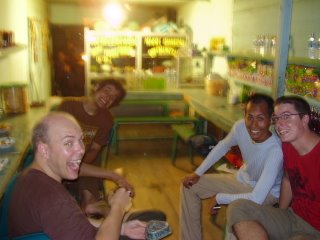 rd to bear and I think I ejected most of it out of my memory but there is a misleading picture I took in the nameless restaurant we ate at. We were surprised to figure we were all alive the next day…
rd to bear and I think I ejected most of it out of my memory but there is a misleading picture I took in the nameless restaurant we ate at. We were surprised to figure we were all alive the next day…
The saddest thing about Kumai was not the noise, the dirt, the smells, the lack of alcohol, clean water and electricity, nor the (can't find the correct adjective here) toilet, the overpopulation of the mosquitoes, not even the stagnant modernism vs. fundamental religion debate of the people we met (which I found very hard to bear), but the fact that powdered milk, insoluble coffee (Nescafé), Coke and Sprite, and Marlboro to be available everywhere and nothing that looked vaguely edible, fresh, natural although we were only three hours away from one of the world's most beautiful rainforests and in the country of some of the best coffee in the world…
The happiest thing about Kumai was leaving it (although those that have left a week after we did on 30th of December would not say that: the ferry sank). When we set sail towards the Orang Utan forests everything turned from a nightmare into a dream…
 We lost Ismail Cem today.
We lost Ismail Cem today.Çok ileri bir tarihte
Çok yaşlı olarak
Sessizce ayrılmalıyım
Kimseye pek gözükmeden
Ve kimseyi rahatsız etmeden.
**
Masamın üzerinde
Dünden kalan işler
Tamamlanmamış yazılar
Okunmayı bekleyen kitaplar
Ve anılar ve umutlar.
**
Filleri kuyruğundan çekerek
Tepeleri aşırtmaktı görevim
Günler bitti filler tükenmedi
Ben elimden geleni yaptım
Gerisini siz tamamlayın.
**
Boşa geçmedi hayatım
Daha fazlası olabilirdi ama
'Buna da şükür' demeliyim
İşte sevgili dostlar
Ben böyle veda etmeliyim.
İsmail Cem,New York, 1995

I get angry but my sadness covers the flames of that anger.But how can one expect that after this very event? see, I cannot write about this.
I'm less today and I cannot fill that gap myself. I can only hope that there will be many more Armenians to do what he did (and more) who will give me a part of my own identity back.

 If I painted Aceh, I would paint it yellowish green and gray despite its golden sandy beaches and turquoise sea. I would paint a pointillist oil on canvas or otherwise with sharp and curvy almost calligraphic ink and pastels on cardboard. So much is hidden - not even intentionally concealed, but rather scattered and lost, hard to notice or recognise…
If I painted Aceh, I would paint it yellowish green and gray despite its golden sandy beaches and turquoise sea. I would paint a pointillist oil on canvas or otherwise with sharp and curvy almost calligraphic ink and pastels on cardboard. So much is hidden - not even intentionally concealed, but rather scattered and lost, hard to notice or recognise… 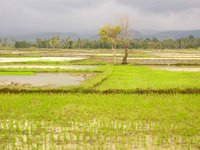 From the very start, I knew most of Aceh would remain unknown to me as anyone who stays only a few days there. So I tried the polsci trick: I read all about its politics, I checked previous student papers that I wrote on Indonesia and Aceh, I kept an eye on the newspapers and tried to use political science as my entry point to a somehat better understanding.
From the very start, I knew most of Aceh would remain unknown to me as anyone who stays only a few days there. So I tried the polsci trick: I read all about its politics, I checked previous student papers that I wrote on Indonesia and Aceh, I kept an eye on the newspapers and tried to use political science as my entry point to a somehat better understanding.
You see, impressions and politics is one and only one posting therefore…
By the t ime I was studying Southeast Asia, it was slowly becoming obvious that East Timor (Timor Leste) was going to separate from Indonesia. One of the most important questions was whether this authoritarian, multi-religious country of thousands of islands and hundreds of languages would unravel or not. Aceh was thought of as the next region to separate if there were such a domino effect. This is what I wrote then:
ime I was studying Southeast Asia, it was slowly becoming obvious that East Timor (Timor Leste) was going to separate from Indonesia. One of the most important questions was whether this authoritarian, multi-religious country of thousands of islands and hundreds of languages would unravel or not. Aceh was thought of as the next region to separate if there were such a domino effect. This is what I wrote then:
“However, Aceh differs from East Timor considerably with its largely Muslim population, and shared colonial history under the Dutch rule, like the rest of Indonesia. The separatist movement in Aceh basis its disagreements with the central government on two critical policies: the ruthless oppression of the military, and the channelling of revenues to Jakarta. Despite its regionalist leader Tengku Hasan M. di Tiro’s struggle against the central rule, it is unlikely that Aceh will separate from Indonesia. Firstly, di Tiro’s influence is declining as he has been away from the country for many years, as well as his age, 72 as of 2002. Moreover, Aceh has experienced a relatively quicker development of infrastructure and welfare compared to East Timor or Iriyan Jaya. It can be argued that the depletion of its LPG resources may necessitate the region to rely on a larger economic entity. Changes in the revenue distribution policies and lessening military pressure (increasing the autonomy of the region) can easily keep Aceh as a part of Indonesia, especially if the decentralisation of centre-region governance structure continues.”
Of course, I couldn’t have guessed the tsunami’s effect. With the tsunami the whole political landscape of Aceh has changed once and for all –let’s hope not until the next disaster…
Wikipedia has some handy information regarding the colonial history of Aceh, but the more recent confrontation is covered by Z-Net (slightly abridged by myself) as of 2002 (for a shorter timeline visit CNN):
“The Indonesian province of Aceh, with a population of around 5 million, is located on the northern-most part of the island of Sumatra, about 1,000 miles from the Indonesian capital Jakarta. Located strategically on the sea lanes between south and east Asia, it became the centre of a powerful trading empire during the 16th and 17th centuries, and one of the earliest Islamic sultanates in southeast Asia.
The people of Aceh have a long history of resistance. For 150 years they thwarted Portuguese and Dutch military efforts to 'pacify' the region and incorporate it in to their colonial empire. After Indonesia's independence in 1945, dissatisfaction with the central government eventually led to the granting of Special Region status, giving the Acehnese control over education, religion and adat (customary) law. However, the decision failed to be implemented. By the mid-1970s after huge natural gas reserves were discovered, blatantly unequal distribution of revenue drawn from the exploitation of these resources contributed to the formation of Gerakan Aceh Merdeka (GAM- Free Aceh Movement) in 1976 and open resistance to central government.
to their colonial empire. After Indonesia's independence in 1945, dissatisfaction with the central government eventually led to the granting of Special Region status, giving the Acehnese control over education, religion and adat (customary) law. However, the decision failed to be implemented. By the mid-1970s after huge natural gas reserves were discovered, blatantly unequal distribution of revenue drawn from the exploitation of these resources contributed to the formation of Gerakan Aceh Merdeka (GAM- Free Aceh Movement) in 1976 and open resistance to central government.
The Suharto regime responded with a campaign of brutality and repression, which reached a peak when Aceh was designated a 'military operations zone' from 1989 until the fall of Suharto in 1998. Thousands of Acehnese men, women and children were killed, tortured or disappeared. After the fall of Suharto, the people of Aceh spoke out publicly for the first time about the years of the terror and brutality, bringing them to national and international attention. Overwhelmed by this torrent of accusations, the head of the armed forces, General Wiranto, announced the end of DOM in August 1998 and apologised for all the abuses. However, neither the governments of Habibie nor Wahid, nor the military, took steps to respond to the demands for justice and compensation by the people of Aceh and no steps have been taken to bring those responsible to trial. During 1999 and 2000, a series of code-named military operations were conducted and there were several massacres in which scores of people were killed.
Exxon/Mobil
Aceh's natural gas has been exploited since 1971 by Mobil Oil, which in 1999 merged with Exxon to become Exxon/Mobil. It operates in partnership with the state oil company, Pertamina, which runs the liquified natural gas plant nearby. The installations are closely guarded by troops who have been responsible over the years for numerous abuses against villagers living in the vicinity of the plant. In June 2001, a lawsuit was filed in the US against the company on behalf of 11 plaintiffs living near the plants.The growth of GAM
Meanwhile, as the Indonesian armed forces became increasingly discredited, the armed resistance, GAM, gained in strength and popularity. Its units now operate in all parts of Aceh and in large swathes of the province it is in effective control of village and local administrations.
Since late 1999, there has been a strong movement in favour of holding a referendum to determined Aceh's future status, as the peaceful way of solving the conflict.
The Negotiations
On the initiative of former president, Abdurrahman Wahid, negotiations were held between the Indonesian Government and GAM, leading to a 'Humanitarian Pause' in June 2000. The armed forces were never happy about this accord and the Pause barely affected the level of killings and the talks have now been suspended indefinitely.
Following a decision by Exxon/Mobil in March 2001 to suspend operations, putting at risk monthly revenues of $100 million and the possible loss of international markets, the armed forces prevailed upon a seriously weakened Wahid to issue a 'presidential instruction' to restore Indonesian administrative control. As pressure mounted for Wahid to be replaced by his vice-president, Megawati Sukarnoputri, the armed forces moved to sabotage what remained of the faltering peace process. During 2001, nearly two thousand people were killed, the vast majority civilians.
The Megawati Presidency
Unlike her predecessor, Megawati fully supported all-out military action to suppress threats to what she prizes above all else, maintaining the Unitary Republic of Indonesia. In late 2001, she ordered the troops 'to hold the country together' regardless of whether this means violating human rights.”
T he tsunami led to a peace agreement between the government of Indonesia and the Free Aceh Movement (GAM), in August 2005. This was to some extent the result of an inflow of international development workers. Before the tsunami, the central government allowed no international visitors to Aceh. On the other hand, the inflow of development aid also had an influence. At the moment, the BBR, a governmental bank, is taking care of the resconstruction in Aceh and managing most of the development aid. In two years all this money will be left to the local government. The agreement between the government and the GAM seems to be around these lines: If the GAM wins the elections and quits its separatist claims the central government would not intervene with the results of the election. (democracy takes weird shapes and forms in the southeast of the globe…)
he tsunami led to a peace agreement between the government of Indonesia and the Free Aceh Movement (GAM), in August 2005. This was to some extent the result of an inflow of international development workers. Before the tsunami, the central government allowed no international visitors to Aceh. On the other hand, the inflow of development aid also had an influence. At the moment, the BBR, a governmental bank, is taking care of the resconstruction in Aceh and managing most of the development aid. In two years all this money will be left to the local government. The agreement between the government and the GAM seems to be around these lines: If the GAM wins the elections and quits its separatist claims the central government would not intervene with the results of the election. (democracy takes weird shapes and forms in the southeast of the globe…)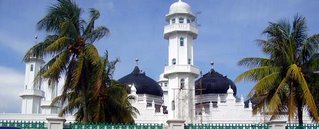
As of December 2006, the peace has held. In 1959 the Indonesian government yielded in part and gave Aceh a "special territory" status, giving it a greater degree of autonomy from the central government in Jakarta than most other regions of Indonesia have. For example, the regional government is empowered to construct a legal system independent of the national government. In 2003, a form of sharia, or Islamic law, was formally introduced in Aceh. In my opinion, this kind of autonomy is not playing into the hands of GAM leaders. Inste ad it is a way of creating power balance between religious leaders and the GAM, who has never demanded sharia law to be implemented, but rather economic reforms that would allow Aceh to utilise its revenues. Nor do the people seem too interested in sharia. The hotel I stayed in was suffocating with rules
ad it is a way of creating power balance between religious leaders and the GAM, who has never demanded sharia law to be implemented, but rather economic reforms that would allow Aceh to utilise its revenues. Nor do the people seem too interested in sharia. The hotel I stayed in was suffocating with rules and norms hanging all over its walls in frames and photocopies, warning against men and women staying together without a marriage document, and it had a general oppressive character that I find very hard to describe but do recognise from a distant past. It was a scary place. Out on the street all Acehnese women and girls (including newly born girl babies) wear headscarves (and every now and then you see some of them taking it out the moment they are in their workplace, or a somewhat more comfortable environment). The clothing and eating rules of sharia doesn’t apply to Indonesians from other regions/religions or to foreigners so these women (myself included) don’t have to wear scarves but long sleeves and trousers. You can even find some beer (see pics), to go with the almost hedonistic food we have had. It was a surprise: I had my best ever Indonesian food in Aceh. It wasn’t primarily Acehnese, as they are more into curry, but the restaurant we have been to almost every night had delicacies ranging f
and norms hanging all over its walls in frames and photocopies, warning against men and women staying together without a marriage document, and it had a general oppressive character that I find very hard to describe but do recognise from a distant past. It was a scary place. Out on the street all Acehnese women and girls (including newly born girl babies) wear headscarves (and every now and then you see some of them taking it out the moment they are in their workplace, or a somewhat more comfortable environment). The clothing and eating rules of sharia doesn’t apply to Indonesians from other regions/religions or to foreigners so these women (myself included) don’t have to wear scarves but long sleeves and trousers. You can even find some beer (see pics), to go with the almost hedonistic food we have had. It was a surprise: I had my best ever Indonesian food in Aceh. It wasn’t primarily Acehnese, as they are more into curry, but the restaurant we have been to almost every night had delicacies ranging f rom sea cucumbers to wild looking whole fish and sea urchins and all sorts of weird vegetables that can hardly recall any further. Even tofu tasted great! The restaurant owner was the creator of this variety and told us what he experimented recently. I missed the usual fruit platte
rom sea cucumbers to wild looking whole fish and sea urchins and all sorts of weird vegetables that can hardly recall any further. Even tofu tasted great! The restaurant owner was the creator of this variety and told us what he experimented recently. I missed the usual fruit platte rs I got so used to nevertheless... This was one of the restaurants that served beer, and without any disturbance either. I mean, you didn’t feel bad drinking it, which is quite important. There were other places, too and I appreciate the flexibility people had. As a result even when dressed differently and not sharing their views on alcohol you don’t see a disturbing look in anyone’s face (when this happens, especially with women, I find it very appalling and hard to bear). So the election results were not a landslide towards more religious parties: the GAM won big time.
rs I got so used to nevertheless... This was one of the restaurants that served beer, and without any disturbance either. I mean, you didn’t feel bad drinking it, which is quite important. There were other places, too and I appreciate the flexibility people had. As a result even when dressed differently and not sharing their views on alcohol you don’t see a disturbing look in anyone’s face (when this happens, especially with women, I find it very appalling and hard to bear). So the election results were not a landslide towards more religious parties: the GAM won big time.
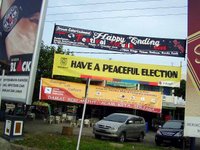 So, I was there right after the first democratic local ele
So, I was there right after the first democratic local ele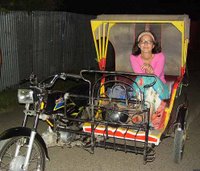 ctions of Aceh took place. The military was constantly passing comments on the media that Aceh was a part of Indonesia and it’d better remain so. The government was agreeing, and highlighting the ultra-democratic stance that they were taking regarding the election results. The Indonesians that I spoke to after I was out of Aceh were mostly playing the results down, saying that this population is so confused that “they simply want to try something new by electing the GAM.” I can understand that the oppression hasn’t only come from the central government in the last decades but also from a movement that required a lot of cash flow. Yet, I don’t think the people vote for the GAM out of hopelessness or ignorance. I would expect the village heads or traditional leaders having an influence on the voters and I would expect GAM to have impressed them in one way or the
ctions of Aceh took place. The military was constantly passing comments on the media that Aceh was a part of Indonesia and it’d better remain so. The government was agreeing, and highlighting the ultra-democratic stance that they were taking regarding the election results. The Indonesians that I spoke to after I was out of Aceh were mostly playing the results down, saying that this population is so confused that “they simply want to try something new by electing the GAM.” I can understand that the oppression hasn’t only come from the central government in the last decades but also from a movement that required a lot of cash flow. Yet, I don’t think the people vote for the GAM out of hopelessness or ignorance. I would expect the village heads or traditional leaders having an influence on the voters and I would expect GAM to have impressed them in one way or the  other. Patronage never dies…
other. Patronage never dies…
Let’s hope peace prevails… It’s a scary thing if the interests of big corporations are secured before the political stability, and that has been my worry in Aceh. Not only Exxon. The coffee corporations buy the world’s top quality coffee beans from Aceh (and it tastes too good to be true). They have the plantations restored and try to create ways to ensure constant high quality harvests. I would rather drink it the Acehnese way rather than the Starbucks and Nescafe versions. It was therefore very surprising not to be able to find any of it out of Aceh, in our next stops such as Kumai, Kalimantan, or Lombok but Nescafe in little plastic bags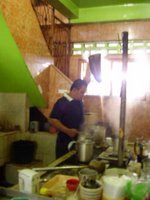 was available everywhere (literally!). The coffee shop was my last stop before the airport, and it’s a pity I bought only a few packs of Takengon coffee and not the whole of the stock ;) They made it in perverse looking filters (see pics) yet it was absolutely sobering and it was the best last stop I could imagine before taking off to Java to meet Harro and his mysterious gang and take a flight to Kalimantan to the Orang Utan Forests...
was available everywhere (literally!). The coffee shop was my last stop before the airport, and it’s a pity I bought only a few packs of Takengon coffee and not the whole of the stock ;) They made it in perverse looking filters (see pics) yet it was absolutely sobering and it was the best last stop I could imagine before taking off to Java to meet Harro and his mysterious gang and take a flight to Kalimantan to the Orang Utan Forests...
 My next stop was Aceh.
My next stop was Aceh. "Why on earth?" was the question I received from a number of fr iends, and although the main reason was that I wanted to see a friend of mine, Meynar, who is doing tsunami relief work for the last few years with MercyCorps there, I also thought that this would be one of the most interesting part of my trip. What you see in Bali is what you are allowed to see, and what you are expected to like (it doesn’t cancel out that it is marvellous). What you see in Java, are the very (very!) impressive natural and cultural
iends, and although the main reason was that I wanted to see a friend of mine, Meynar, who is doing tsunami relief work for the last few years with MercyCorps there, I also thought that this would be one of the most interesting part of my trip. What you see in Bali is what you are allowed to see, and what you are expected to like (it doesn’t cancel out that it is marvellous). What you see in Java, are the very (very!) impressive natural and cultural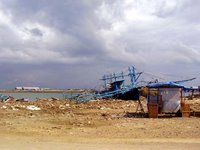 heritages (which I skipped for this time, and I know I will go back to them), but what you see in Aceh is real life at its best (and worst). So that was the end of my tourist life in Indonesia and I got my ticket to Aceh, a little concerned about what it would be like under shariyah, a little excited to see Meynar again (in the pics), a little worried if I could bare the effects of the tsunami and the earthquake...
heritages (which I skipped for this time, and I know I will go back to them), but what you see in Aceh is real life at its best (and worst). So that was the end of my tourist life in Indonesia and I got my ticket to Aceh, a little concerned about what it would be like under shariyah, a little excited to see Meynar again (in the pics), a little worried if I could bare the effects of the tsunami and the earthquake...
I wasn’t wrong. It was remarkable. I was there right after the first elections that were held in the tsunami- and conflict-hit region. The main reason of course, being Meynar, who not only allowed me to see her microfinance work there, but also gave me a great insight about the area, with our conversations as well as a tour of the projects, and landscapes. It was great to see development workers on the field, how our concepts merged and how researchers and implementers influenced one another.
If I were to part my story of Aceh into three, the main concepts would be the tsunami, the politics, and some impressions (though they are very interconnected I must admit). I can’t tell my story without these backgrounds, so I should start with the tsunami.
Aceh was the closest point of land to the epicenter of the massive 2004 Indian Ocean earthquake, which triggered a tsunami that devastated much of the western coast of the region, including part of the capital of Banda Aceh (see map). Over 200,000 people died, and over 500,000 were left homeless. This happened on a Sunday when most men and kids were at home, and women on the market. The kids couldn’t have resisted the strength of the tsunami. They were washed away with the 40m high waves. The men that died and were missing were the main wage-earner of their families, hence the social structure has been tremendously influenced. Some villages on the shore were destroyed so irreparably that the fishing communities cannot go back there, and need to find a different way of organising their livelihoods in the forests and mountains.
To demonstrate… The tsunami took a bite of this hill (“mountain” in a Dutch scale) and took it away.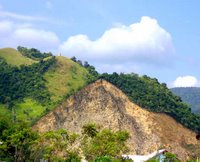
It carried this floating electricity generator (which used to be sent back and forth between islands, wherever it is needed) 20 kms inland and now cannot be removed. The wave reached as far as 40km. inland.
After the tsunami, the short-term relief work has taken a few months, but in the long term a whole economy has vanished therefore the international aid was critical. The picture of the cardboard box on the right says “Tsunami is God’s way of reminding people to help one another”. Yet, the Achenese response was not fatalist at all: Many victims who survived say that it is a new start, there’s no point in whining and should start all over again. For these people the international aid is significant as it allows them to find the means to start new businesses. Some microfinance projects seem to work very effectively in reorganising a wiped out economy. This is particularly true for less agricultural parts of Aceh.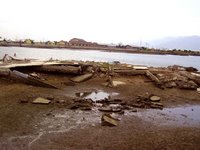
I was very impressed by two projects in particular: the mushroom project, and the village communities one. The mushroom project is a partnership between ILO and MercyCorps,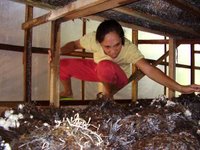 which constructed an indoor mushroom growing building for 10 women of
which constructed an indoor mushroom growing building for 10 women of a village. It takes them only a week per month to take care of the mushrooms, which are hard to find and hence quite expensive in Aceh. They are so proud and happy about their work that they want to build more of them for more women and asked Meynar’s help to apply for some funds. A few pics:
a village. It takes them only a week per month to take care of the mushrooms, which are hard to find and hence quite expensive in Aceh. They are so proud and happy about their work that they want to build more of them for more women and asked Meynar’s help to apply for some funds. A few pics: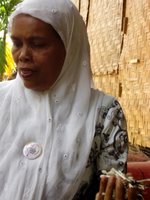
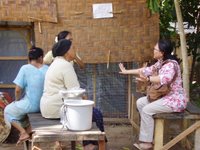
The latter is the Village Communities project that MercyCorps and WWF were doing together in which they asked the village communities how they would like to reorganise their economies, assessing the ecological and social structures as well. They said bumped into a number of problems regarding the participation of vulnerable groups, but they were constantly making an effort to ensure some deliberation all the time. The way Acehnese villages were formed (possibly related to their colonial past) seems to help: There are youth groups, women’s groups, etc. in each and every community, which they can try to strengthen.
 Did you donate for the tsunami relief? I did. I know a lot of people that did. Do have any ideas how your donation has been spent? Well, the donation I made to Red Crescent of Turkey was spent into boats that Acehnese people didn't know how to use, and to buildings they didn't bother moving into, as they were too small for Acehnese culture (and the rebuilding of a mosque around which noone lived, see pic). This is partly related to what they refer to as the spoilt market: There is so much choice for funds that most communities that have some kind of a project in mind can choose from among a number of donors. But more importantly, several people regarded the Turkish aid as very well organised and fast in the rescue missions, and quite insensible in the aftermath.
Did you donate for the tsunami relief? I did. I know a lot of people that did. Do have any ideas how your donation has been spent? Well, the donation I made to Red Crescent of Turkey was spent into boats that Acehnese people didn't know how to use, and to buildings they didn't bother moving into, as they were too small for Acehnese culture (and the rebuilding of a mosque around which noone lived, see pic). This is partly related to what they refer to as the spoilt market: There is so much choice for funds that most communities that have some kind of a project in mind can choose from among a number of donors. But more importantly, several people regarded the Turkish aid as very well organised and fast in the rescue missions, and quite insensible in the aftermath.  The Turkish village as they call it, was deserted other than some construction workers putting Turkish flags on each house (pathetic). And sadly, there were several families living in one room huts (or a combination of huts as in the pic) rather than moving into those areas which were no longer residential.
The Turkish village as they call it, was deserted other than some construction workers putting Turkish flags on each house (pathetic). And sadly, there were several families living in one room huts (or a combination of huts as in the pic) rather than moving into those areas which were no longer residential.
 So were the full moon photos of our romantic dinner (which he felt out of place as he puts it -or thinks that he should) ;)
So were the full moon photos of our romantic dinner (which he felt out of place as he puts it -or thinks that he should) ;)
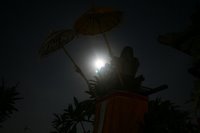 This was the temple that we had as the view before the moonrise...
This was the temple that we had as the view before the moonrise... My picture at the Hyatt certainly wasn't taken by me either (I like this one. It's pretty rare that I look good OR like myself in pictures, this is somehow both).
My picture at the Hyatt certainly wasn't taken by me either (I like this one. It's pretty rare that I look good OR like myself in pictures, this is somehow both).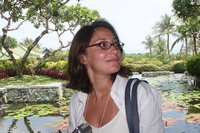 And when I said the conference site was nice, this was what I meant...
And when I said the conference site was nice, this was what I meant...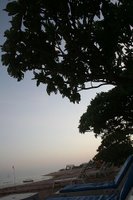
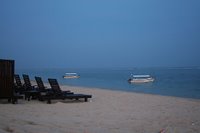 But I must have taken at least this one: Sander with "the Bible"... I don't know what we would do without our beloved Lonely Planet (despite the night in Aloha Inn)
But I must have taken at least this one: Sander with "the Bible"... I don't know what we would do without our beloved Lonely Planet (despite the night in Aloha Inn)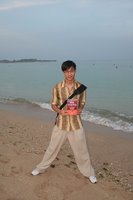 Thanks Sander.
Thanks Sander.
I did have long walks on the beach and a lot of writing on my life in Amsterdam –the kind of writing that requires some mental and physical distance.
I managed to resume horseriding, on Seminyak beach early in the morning before the beach was crowded.
I started to read Max Havelaar, or the Coffee Auctions of the Dutch Trading Company (@amazon), by far the best book I read about colonialism and one of the best novels I read.
The next leg of my trip was to Nusa Dua, a peninsula in the south of Bali located 40 kilometres from the capital city of Denpasar. The conference site was there so I had to take a taxi to the other side of the little tail of Bali. The Conference being the IDGEC Synthesis Conference, my reason for going to Bali in the first place.
IDGEC is a long-term international research project developed during the 1990s under the auspices of the International Human Dimensions Programme on Global Environmental Change (IHDP). IHDP is an international, interdisciplinary, non-governmental science programme dedicated to promoting, catalyzing and coordinating research on the human dimensions of global environmental  change. IHDP takes a social science perspective on global change and it works at the interface between science and practice.
change. IHDP takes a social science perspective on global change and it works at the interface between science and practice.
The conference was held in Grand Hyatt Bali Hotel but most PhD students stayed in a nearby hotel called Inna Putri Bali which was relatively less extravagant. The reason was that this hotel was cheaper and less luxurious and PhD students like making a point out of that. I am no different. I find it curious to fly from one continent to the other to d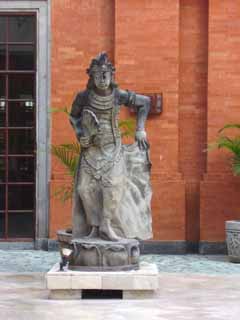 iscuss climate change, or to stay in a luxurious hotel to figure the ways in which science and practice of environmental issues can be brought together (pics from the hotel make my point). Yet, that’s the way it is and reading Science in Action (@amazon) by Bruno Latour and the Postmodern Condition (@amazon) by Jean-Francois Lyotard helped keep my dignity. Of course, the conference itself as well. It is always a great feeling to be below the average level of brightness around (yet, I wont go further into that as it would be professional gossiping ;) –and possibly bore you to death).
iscuss climate change, or to stay in a luxurious hotel to figure the ways in which science and practice of environmental issues can be brought together (pics from the hotel make my point). Yet, that’s the way it is and reading Science in Action (@amazon) by Bruno Latour and the Postmodern Condition (@amazon) by Jean-Francois Lyotard helped keep my dignity. Of course, the conference itself as well. It is always a great feeling to be below the average level of brightness around (yet, I wont go further into that as it would be professional gossiping ;) –and possibly bore you to death).
The results of doing those readings (but not emerging from their content), to my surprise were the following:
1. a few nice chats, and insights to previous works of my colleagues,
2. a lot of remarks and criticisms from colleagues who obviously found it useless to try to read these authors on the beach
3. a reminder that I shouldn’t travel with that many books (from my bag pack)
The results of doing those readings (this time related to their content) were the following:
1. figuring that I will not in the near-future read any further Lyotard, although I think the book was marvellous, simply because the relevance of the subject matter is not sufficient to motivate my curiosity and overcome the language barrier.
2. that I have to spend some more time reading Latour, I think he was the greatest discovery of my trip. I enjoyed looking at the institutions that I am involved in and how they shape and form myself and my work as well as that of people I share mental spaces with.
3. that I shouldn’t surrender: one can, and I believe I could, share parts of some thoughts, inspirations, questions, and difficulties with some friends around and sometimes even despite themselves. This does save one from being excluded (hence, demented and angry), at least in my case. It was, therefore, a tremendously rewarding experience.
4. and a bunch of little ideas that I will have to work on in the next few months.
Another great thing about the Conference was the start of my field work, which got me terribly excited. And lastly, I enjoyed getting some feedback about our multi-authored paper.
All in all it was a good conference even without mentioning the immense variety of tastes we have been exposed to. It was great to have fruit platter on the coffee breaks, and sunshine and a blue-green sea in the midst of flower gardens throughout the conference.
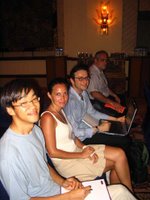 I should also cite a wonderful dinner with Sander before the conference started (a conversation on the issue of guilt in religion, some indescribably good food, a wonderful moonrise over the ocean, some bottles of Bintang –the star/beer of Indonesia, the main source of alcohol we had throughout the week-, huge crabs on the shore as we walked back, a night long chanting in the temple nearby, a smal
I should also cite a wonderful dinner with Sander before the conference started (a conversation on the issue of guilt in religion, some indescribably good food, a wonderful moonrise over the ocean, some bottles of Bintang –the star/beer of Indonesia, the main source of alcohol we had throughout the week-, huge crabs on the shore as we walked back, a night long chanting in the temple nearby, a smal l visit there and taking pictures of all these...), a walk with Fari on the possibilities of me understanding more of Lyotard and rest of life/work, meeting some people who I know and appreciate the work of in person, great Balinese dances we had a chance to watch, a late night chat with Harro (that helped me figure what I look like to unfamiliar eyes), nightswimming with the department and the luxury of seeing everyone less stressed and busy than usual, with the possible exception of Sander who seemed a little worried about his capabilities of networking. I know I can network and I don’t choose to. I think we should be able to relate at the level of ideas (and at times as individuals that enjoy talking, thinking, working on similar issues, or even just sharing the same physical environment). There is no need to ultra-professionalise the environment that we obviously find worth being in. I am afraid this also relates to my incapabilities of looking sharp in two seconds and impress people in a claculated manner. So I don’t play the game. And there are many people who don’t. I liked figuring that out in this conference. I understand his worry and I truly think he should be in conferences alone so as to test his capabilities and yet he will rejoice (he has a posting on this matter).
l visit there and taking pictures of all these...), a walk with Fari on the possibilities of me understanding more of Lyotard and rest of life/work, meeting some people who I know and appreciate the work of in person, great Balinese dances we had a chance to watch, a late night chat with Harro (that helped me figure what I look like to unfamiliar eyes), nightswimming with the department and the luxury of seeing everyone less stressed and busy than usual, with the possible exception of Sander who seemed a little worried about his capabilities of networking. I know I can network and I don’t choose to. I think we should be able to relate at the level of ideas (and at times as individuals that enjoy talking, thinking, working on similar issues, or even just sharing the same physical environment). There is no need to ultra-professionalise the environment that we obviously find worth being in. I am afraid this also relates to my incapabilities of looking sharp in two seconds and impress people in a claculated manner. So I don’t play the game. And there are many people who don’t. I liked figuring that out in this conference. I understand his worry and I truly think he should be in conferences alone so as to test his capabilities and yet he will rejoice (he has a posting on this matter).
That was more or less all about my trip to Nusa Dua... Next, I went back to Kuta/Legian/Seminyak for a few days of solitude. How could I know that I would find an island in my head only a few weeks later where I would feel most wonderfully alone, and yet still with friends.
ps. last two pics are harro's click...